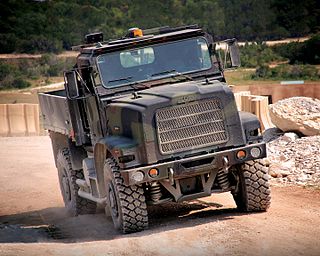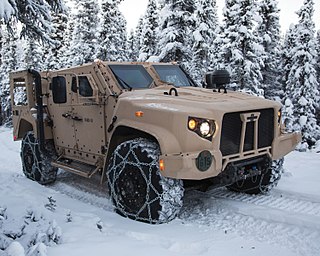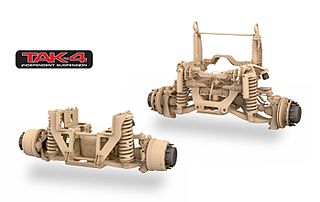
The High Mobility Multipurpose Wheeled Vehicle is a family of light, four-wheel drive, military trucks and utility vehicles produced by AM General. It has largely supplanted the roles previously performed by the original jeep, and others such as the Vietnam War-era M151 jeep, the M561 "Gama Goat", their M718A1 and M792 ambulance versions, the Commercial Utility Cargo Vehicle, and other light trucks. Primarily used by the United States military, it is also used by numerous other countries and organizations and even in civilian adaptations. The Humvee saw widespread use in the Gulf War of 1991, where it navigated the treacherous desert terrain; this usage helped to inspire civilian Hummer versions. The vehicle's original unarmored design was later seen to be inadequate. The vehicle was found to be particularly vulnerable to improvised explosive devices in the Iraq War. The U.S. hastily up-armored select models and replaced front-line units with the MRAP. The U.S. military sought to replace the vehicle in front-line service under the Joint Light Tactical Vehicle (JLTV) program. In 2015 the Oshkosh L-ATV was selected for production.

The Heavy Expanded Mobility Tactical Truck (HEMTT) is an eight-wheel drive, diesel-powered, 10-short-ton (9,100 kg) tactical truck. The M977 HEMTT first entered service in 1982 with the United States Army as a replacement for the M520 Goer, and since that date has remained in production for the U.S. Army and other nations. By Q2 2021, around 35,800 HEMTTs in various configurations had been produced by Oshkosh Defense through new-build contracts and around 14,000 of these had been re-manufactured. Current variants have the A4 suffix.

Oshkosh Corporation, formerly Oshkosh Truck, is an American industrial company that designs and builds specialty trucks, military vehicles, truck bodies, airport fire apparatus, and access equipment. The corporation also owns Pierce Manufacturing, a fire apparatus manufacturer in Appleton, Wisconsin, and JLG Industries, a leading manufacturer of lift equipment, including aerial lifts, boom lifts, scissor lifts, telehandlers and low-level access lifts. Based in Oshkosh, Wisconsin, the company employs approximately 16,000 people around the world. It is organized in four primary business groups: access equipment, defense, fire and emergency, and commercial.

The Family of Medium Tactical Vehicles (FMTV) is a series of vehicles, based on a common chassis, that vary by payload and mission requirements. The FMTV is derived from the Austrian Steyr 12M18 truck, but substantially modified to meet United States Army requirements, these including a minimum 50 percent U.S. content.

The Palletized Load System (PLS) is a truck-based logistics system that entered service in the United States Army in 1993. It performs long and short distance freight transport, unit resupply, and other missions in the tactical environment to support modernized and highly mobile combat units. It provides rapid movement of combat configured loads of ammunition and all classes of supply, shelters and intermodal containers. It is similar to systems such as the British Demountable Rack Offload and Pickup System (DROPS).

TerraMax is the trademark for autonomous/unmanned ground vehicle technology developed by Oshkosh Defense. Primary military uses for the technology are seen as reconnaissance missions and freight transport in high-risk areas so freeing soldiers from possible attacks, ambushes or the threat of mines and IEDs. The technology could also be used in civilian settings, such as autonomous snow clearing at airports.
Armor Holdings, Inc. was an American manufacturer of military, law enforcement, and personnel safety equipment. It was acquired by BAE Systems on July 31, 2007 and renamed BAE Systems Mobility & Protection Systems. The divisions have been reorganised within BAE Systems Land and Armaments.

The Logistics Vehicle System (LVS), nicknamed by U.S. Marines as "Dragon Wagon", is a modular assortment of eight-wheel drive all-terrain vehicle unit combinations used by the United States Marine Corps.

The Joint Light Tactical Vehicle (JLTV) is a United States military and United States Special Operations Command program to part-replace the Humvee with a family of more survivable vehicles with greater payload. Early studies for the JLTV program were approved in 2006. The JLTV program incorporates lessons learned from the earlier Future Tactical Truck Systems program and other associated efforts.

Plasan is an Israeli based vehicle manufacturer.
The Humvee replacement process, undertaken by the U.S. military, was an effort to replace the current AM General Humvee multi-purpose motor vehicle. The Humvee had evolved several times since its introduction in 1984, and is now used in tactical roles for which it was not originally intended. The U.S. military pursued several initiatives to replace it, both in the short and long term. The short-term replacement efforts utilize commercial off-the-shelf (COTS) vehicles, while the long-term efforts focused on building requirements for the Humvee replacement and technology research and evaluation in the form of various prototype vehicles.
The MillenWorks Light Utility Vehicle (LUV) is a prototype testbed for automotive technologies. It was designed and built by MillenWorks under contract to the Tank Automotive Research, Development and Engineering Center. Textron Marine and Land Systems will use the platform for further development of component technologies. The vehicle was a possible Joint Light Tactical Vehicle candidate, but was not selected.

The M1120 HEMTT LHS is a M977 Heavy Expanded Mobility Tactical Truck with a load handling system in place of a flat bed/cargo body. The HEMTT is an eight-wheel drive, diesel-powered, tactical truck used by the US military and others. The HEMTT is manufactured by Oshkosh Defense and entered Army service in 1982, with the M1120 variant first produced in 1999.

The Oshkosh M-ATV is a Mine-Resistant Ambush Protected (MRAP) vehicle developed by the Oshkosh Corporation for the MRAP All Terrain Vehicle (M-ATV) program. Intended to replace M1114 HMMWVs (Humvee), it is designed to provide the same levels of protection as the larger and heavier previous MRAPs, but with improved mobility.

The Marine Personnel Carrier (MPC) is a wheeled armored personnel carrier under development for acquisition by the United States Marine Corps. The program was canceled in 2013 but resurrected in 2014 as part of phase one of the Amphibious Combat Vehicle.

The Lockheed Martin JLTV is a prototype armor-capable vehicle that was one of six original competitors for a Joint Light Tactical Vehicle that will replace the Humvee. The JLTV goal was to provide a family of vehicles able to perform multiple missions protected, sustained and networked mobility for personnel and payload over a full range of operations. Lockheed's JLTV design lost out to the Oshkosh L-ATV in August 2015.

The Hawkei is a light four-wheel drive protected mobility vehicle originally designed to meet an Australian Defence Force (ADF) requirement for a light armoured patrol vehicle to replace some of its Land Rover Perentie variants. The Hawkei is a highly mobile, highly protected, 7-tonne vehicle, with in-built systems to allow it to be used as a fighting platform. It has been developed with Vehicle Electronic Architecture to be mission system ready. It is intended to undertake a range of mission profiles, including troop movement, command and control, electronic warfare, liaison, surveillance and reconnaissance. Prime contractors include: Thales Australia, Boeing Australia, Plasan (Israel) and PAC Group. In October 2015, the Australian Government announced the purchase of 1,100 Hawkei vehicles from Thales Australia.

The Oshkosh L-ATV is a light utility/combat multi-role vehicle that won the US military's Army-led Joint Light Tactical Vehicle (JLTV) program. In the very early stages of the program it was suggested that JLTV would replace the AM General High Mobility Multi-purpose Wheeled Vehicle (HMMWV) on a one-for-one basis. It is now suggested that the JLTV will part-replace the HMMWV, not replace it on a like-for-like basis.

The Logistic Vehicle System Replacement (LVSR) is a family of heavy-duty military logistics vehicles of the United States Marine Corps (USMC) based on a common 5-axle ten-wheel drive (10x10) chassis. The vehicles vary in individual configuration by mission requirements, with three variants in service: a cargo, a wrecker and a tractor truck. The LVSR was designed and is manufactured by Oshkosh Defense.

TAK-4 independent suspension system is a family of independent suspension systems designed and manufactured by Oshkosh Corporation for use on military, severe-duty and emergency vehicles. The system was developed from the mid-1990s.

















